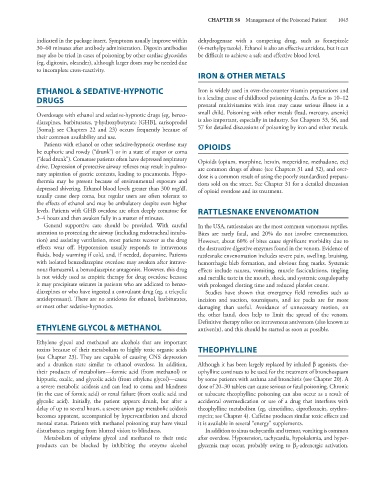Page 1059 - Basic _ Clinical Pharmacology ( PDFDrive )
P. 1059
CHAPTER 58 Management of the Poisoned Patient 1045
indicated in the package insert. Symptoms usually improve within dehydrogenase with a competing drug, such as fomepizole
30–60 minutes after antibody administration. Digoxin antibodies (4-methylpyrazole). Ethanol is also an effective antidote, but it can
may also be tried in cases of poisoning by other cardiac glycosides be difficult to achieve a safe and effective blood level.
(eg, digitoxin, oleander), although larger doses may be needed due
to incomplete cross-reactivity.
IRON & OTHER METALS
ETHANOL & SEDATIVE-HYPNOTIC Iron is widely used in over-the-counter vitamin preparations and
DRUGS is a leading cause of childhood poisoning deaths. As few as 10–12
prenatal multivitamins with iron may cause serious illness in a
Overdosage with ethanol and sedative-hypnotic drugs (eg, benzo- small child. Poisoning with other metals (lead, mercury, arsenic)
diazepines, barbiturates, γ-hydroxybutyrate [GHB], carisoprodol is also important, especially in industry. See Chapters 33, 56, and
[Soma]; see Chapters 22 and 23) occurs frequently because of 57 for detailed discussions of poisoning by iron and other metals.
their common availability and use.
Patients with ethanol or other sedative-hypnotic overdose may OPIOIDS
be euphoric and rowdy (“drunk”) or in a state of stupor or coma
(“dead drunk”). Comatose patients often have depressed respiratory Opioids (opium, morphine, heroin, meperidine, methadone, etc)
drive. Depression of protective airway reflexes may result in pulmo- are common drugs of abuse (see Chapters 31 and 32), and over-
nary aspiration of gastric contents, leading to pneumonia. Hypo- dose is a common result of using the poorly standardized prepara-
thermia may be present because of environmental exposure and tions sold on the street. See Chapter 31 for a detailed discussion
depressed shivering. Ethanol blood levels greater than 300 mg/dL of opioid overdose and its treatment.
usually cause deep coma, but regular users are often tolerant to
the effects of ethanol and may be ambulatory despite even higher
levels. Patients with GHB overdose are often deeply comatose for RATTLESNAKE ENVENOMATION
3–4 hours and then awaken fully in a matter of minutes.
General supportive care should be provided. With careful In the USA, rattlesnakes are the most common venomous reptiles.
attention to protecting the airway (including endotracheal intuba- Bites are rarely fatal, and 20% do not involve envenomation.
tion) and assisting ventilation, most patients recover as the drug However, about 60% of bites cause significant morbidity due to
effects wear off. Hypotension usually responds to intravenous the destructive digestive enzymes found in the venom. Evidence of
fluids, body warming if cold, and, if needed, dopamine. Patients rattlesnake envenomation includes severe pain, swelling, bruising,
with isolated benzodiazepine overdose may awaken after intrave- hemorrhagic bleb formation, and obvious fang marks. Systemic
nous flumazenil, a benzodiazepine antagonist. However, this drug effects include nausea, vomiting, muscle fasciculations, tingling
is not widely used as empiric therapy for drug overdose because and metallic taste in the mouth, shock, and systemic coagulopathy
it may precipitate seizures in patients who are addicted to benzo- with prolonged clotting time and reduced platelet count.
diazepines or who have ingested a convulsant drug (eg, a tricyclic Studies have shown that emergency field remedies such as
antidepressant). There are no antidotes for ethanol, barbiturates, incision and suction, tourniquets, and ice packs are far more
or most other sedative-hypnotics. damaging than useful. Avoidance of unnecessary motion, on
the other hand, does help to limit the spread of the venom.
Definitive therapy relies on intravenous antivenom (also known as
ETHYLENE GLYCOL & METHANOL antivenin), and this should be started as soon as possible.
Ethylene glycol and methanol are alcohols that are important
toxins because of their metabolism to highly toxic organic acids THEOPHYLLINE
(see Chapter 23). They are capable of causing CNS depression
and a drunken state similar to ethanol overdose. In addition, Although it has been largely replaced by inhaled β agonists, the-
their products of metabolism—formic acid (from methanol) or ophylline continues to be used for the treatment of bronchospasm
hippuric, oxalic, and glycolic acids (from ethylene glycol)—cause by some patients with asthma and bronchitis (see Chapter 20). A
a severe metabolic acidosis and can lead to coma and blindness dose of 20–30 tablets can cause serious or fatal poisoning. Chronic
(in the case of formic acid) or renal failure (from oxalic acid and or subacute theophylline poisoning can also occur as a result of
glycolic acid). Initially, the patient appears drunk, but after a accidental overmedication or use of a drug that interferes with
delay of up to several hours, a severe anion gap metabolic acidosis theophylline metabolism (eg, cimetidine, ciprofloxacin, erythro-
becomes apparent, accompanied by hyperventilation and altered mycin; see Chapter 4). Caffeine produces similar toxic effects and
mental status. Patients with methanol poisoning may have visual it is available in several “energy” supplements.
disturbances ranging from blurred vision to blindness. In addition to sinus tachycardia and tremor, vomiting is common
Metabolism of ethylene glycol and methanol to their toxic after overdose. Hypotension, tachycardia, hypokalemia, and hyper-
products can be blocked by inhibiting the enzyme alcohol glycemia may occur, probably owing to β -adrenergic activation.
2

